United States Grand Prix West race report
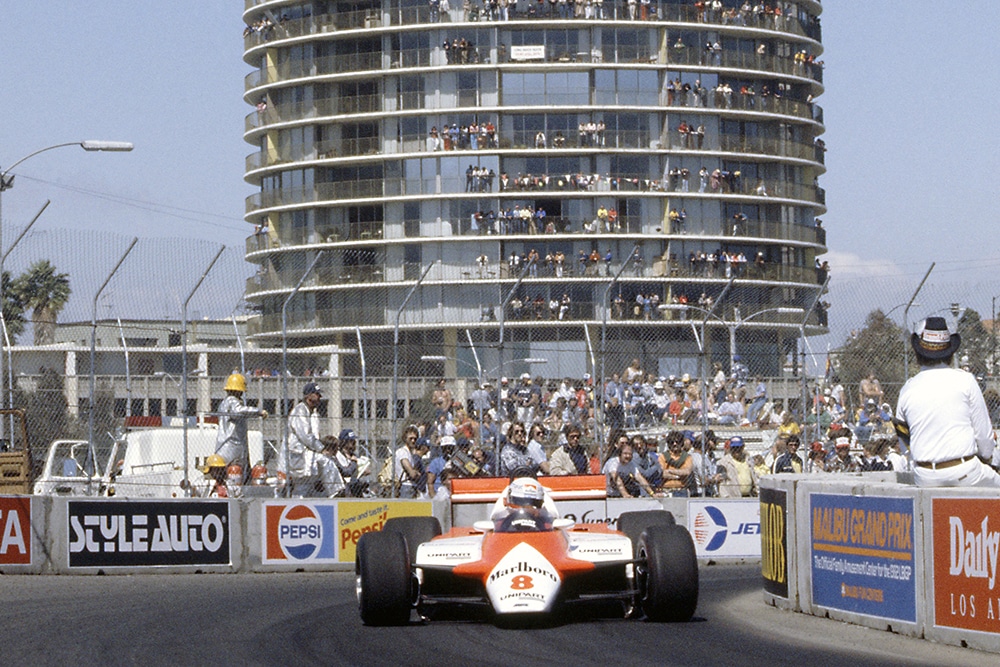
Niki Lauda emerged victorious from his third race back in F1
Motorsport Images
—Lauda the perfectionist
Long Beach, April 4th
WHEN the teams arrived in California, direct from Brazil, there being but one weekend between the two races, they found two major changes. Firstly the street circuit at Long Beach had been revised and secondly Carlos Reutemann had once more retired, this time for good. After some anxious times Frank Williams finally signed up Mario Andretti for this one race as his commitment to Indy Car racing prevented him from joining the team for the rest of the season. The circuit changes were interesting for it is not often that organisers change things for the better, but Chris Pock and his Long Beach Grand Prix Association made a vastly improved circuit with their moveable concrete blocks in my view, though some people thought otherwise. From the start on Shoreline Drive, on the left side of a concrete dual carriageway the circuit used to arrive at a hairpin, sending the cars back the way they had come on the other leg of the dual carriageway, and then after a short distance they turned left and wiggled their way across an open space and up the short-sharp hill to Ocean Boulevard.
Now they turned a right-angle at the old hairpin, across the other leg of the dual carriageway, into a tightening left-hand bend and a short squirt that just touched the dual carriageway before another tightening bend, this time to the right, took them down a short straight to a fast right-hander. From here it was flat out through a long ess-bend to a tricky left-hand bend onto the rise up to Ocean Boulevard and the pit lane. At the other end of the circuit they still plunged down the descent on Linden Avenue to the sharp left-hander at the bottom, but then instead of turning immediately right the circuit now went straight on for a few hundred yards to a right-hand bend that turned back on itself and then fed into the old circuit and the long left-hand bend that took it onto the dual carriageway of Shoreline Drive and up to the hairpin as before. The charge down Shoreline Drive is now interrupted by what is in effect a chicane, the route running off the concrete dual-carriageway to the right, then round a tight left and an opening-out sweep onto the start area and away down the concrete road. This rather tight chicane was not very popular with the drivers as it was impossible to see the entry until you were on top of it, but it is all part of a plan for 1983, when the pit-road is due to be transferred from Ocean Boulevard, in the town itself down to the Shoreline Drive area on the harbour’s edge. The result of all these changes for this year meant a slightly longer circuit, but a much longer lap time and a reduction of some 10 m.p.h. to the average speed.
The only major changes in the entry since the Brazilian race was Andretti taking the place of Reutemann in the Williams team, while Rosberg took over the Brazilian T-car (FW07C/15) as after the race it was found that the Finn’s unruly kerb-bashing had damaged the monocoque of FW07C/17. The “tub” of the test-car FW07/14 was sent out to Long Beach and it was built up to become the team spare car. Watson had changed from McLaren MP4/5 to the team spare (MP4/2) for the Brazilian race and decided he preferred it so kept to it for Long Beach, MP4/5 becoming the T-car. In the Ferrari team Villeneuve took over the T-car from Brazil (126C2/058) after the slight accident with its own car (126C2/057) which was repaired and became the Long Beach T-car. The Toleman-Hart team did a lot of stiffening to their monocoques, with gusset plates and strengthening ribs and the Lotus team were kept busy as Mansell flew off into the rough while testing at the Willow Springs circuit north of Los Angeles.
There was no pre-practice testing on the circuit so everyone was ready for the Friday morning official test-session on the same footing. While the regular drivers who have been to Long Beach before had to learn the new layout, but not the character, the newcomers had to start from scratch and learn about keeping between the concrete walls, allowing for road surface changes, avoiding manhole covers and trying to avoid some of the worst bumps.
Qualifying
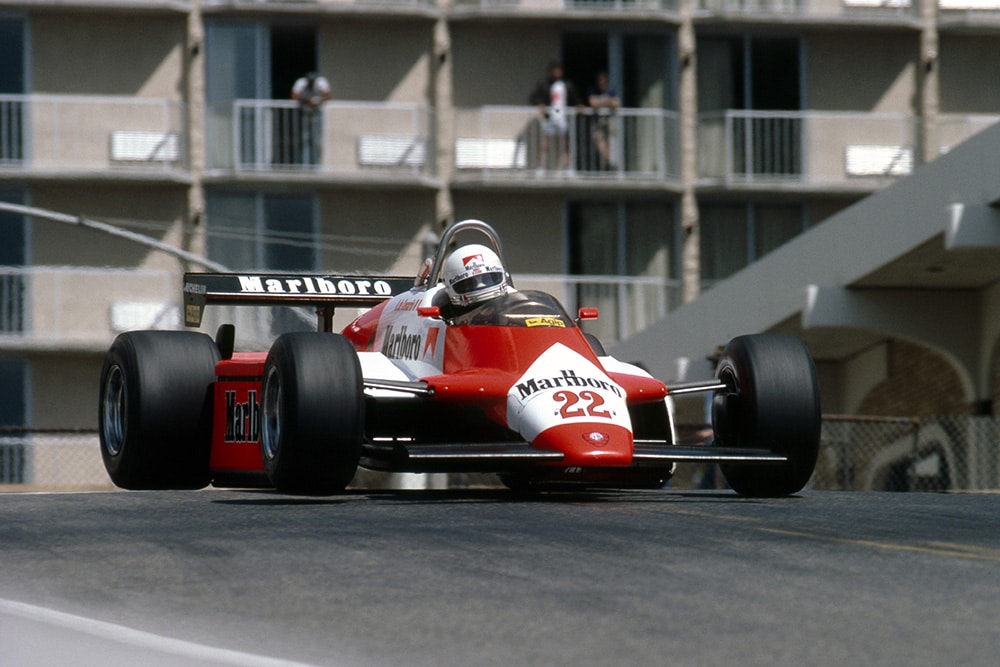
Andrea de Cesaris secured pole position for his new employer Alfa Romeo
Motorsport Images
The Long Beach circuit presents a daunting challenge and has all the rough-and-tumble character of Monaco. It is every bit as good, if not better, than the Monegasque circuit. With seven years’ experience behind them the Long Beach Grand Prix Association run everything very smoothly, and right on the dot the morning test-session was begun at 10 a.m. and Jean-Pierre Jarier was first out of the pit lane in his blue and white Osella. While any lap times recorded did not count for the starting grid, the hour and a half being purely for testing, the times of Boesel (March), Paletti (Osella), Jarier (Osella), Warwick (Toleman) and Fabi (Toleman) were important. Because the infamous Concorde Agreement put a limit of 30 cars on the track for the qualifying hours for the 26 starting grid positions, it meant that someone from the entry of 31 had to be weeded out. Pre-qualifiers have been listed from 1981 performances, so the five drivers mentioned had to spend the first hour and a half trying not to be “tail-end Charlie”. At the end of the morning the slowest of the five would be ruled off. In our brief report on the Brazilian Grand Prix last month we did not mention that this is what happened to Paletti.
During the morning there were numerous spins, off-course excursions, contact with the concrete walls, trips up the escape roads and corner-cutting as drivers found out about the new circuit. By the time the top runners began to get the feel of the new circuit lap times were still more than 10 seconds slower than last year. The chicane on Shoreline Drive seemed to give the most trouble, mainly because of its fast approach speed downhill and hidden entrance. As the morning wore on the surprise was that the two Alfa Romeos were proving quick, both Giacomelli and de Cesaris making good times, while Rosberg, Lauda and Laffite you would expect to be quick. The only serious disaster of the morning was when Patrese hit the wall on the first corner of the new section and drove back to the pits with his right-front wheel and suspension bent back through 90 degrees. The suspension pick-up points within the monocoque were badly damaged and there was no way repairs could be done without the chassis going back on the building-jig, so it meant that the Italian had to take over the spare Brabham-Cosworth and stick with it for the rest of the weekend. This was a 1981 car still to C-specifications, not much different from the new cars, but lacking the detail feature on the D-specification Brabhams.
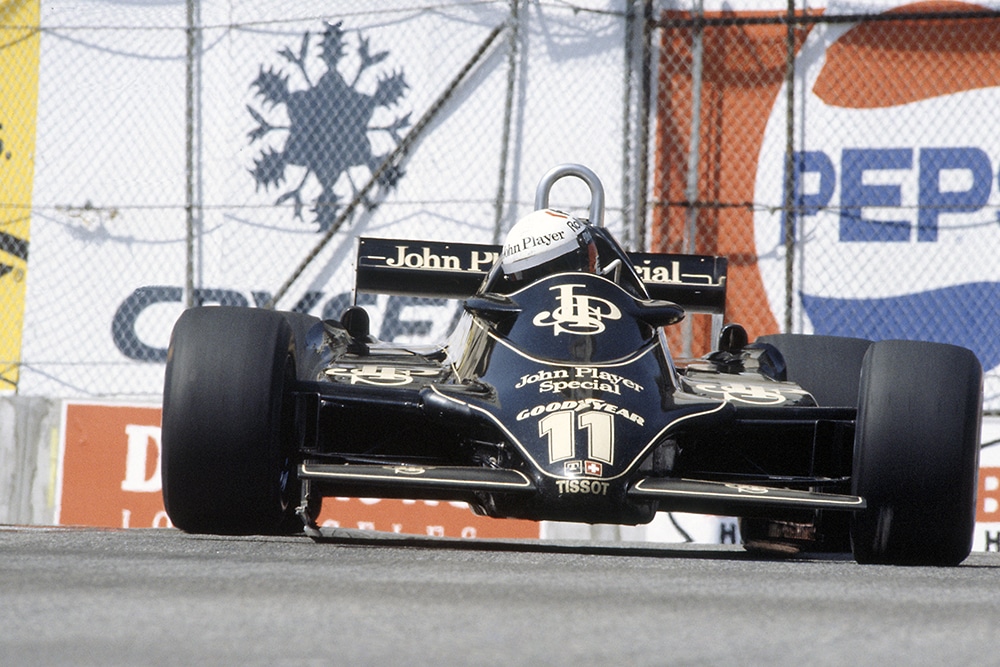
Elio de Angelis found himself down the grid in 16th place after qualifying
© Motorsport Images
The team kept their fingers crossed that Piquet kept out of trouble and did not need the spare car. At the bottom of the field it was the unfortunate Derek Warwick who was “tail-end Charlie” as he had been plagued by a misfire on his “monobloc” Hart engine and it was cured just too late for him to have a real go, so he became a spectator without even trying to qualify for the starting grid.
Although there was rain in California it kept away from the Long Beach area and the hour of qualifying was run promptly to time under clear blue skies. We are still plagued with the stupid rule that limits drivers to just two sets of tyres for the hour-long session, and by all accounts you are lucky to get more than two hard-trying laps from a set before they lose their maximum adhesion. With the possibility of thirty cars circulating the chances of getting a completely clear lap are pretty slim and to listen to some drivers you would think it would be better to draw straws for grid positions. However, in spite of all the mumbo-jumbo talked about “qualifying tyres” and “down force” it is usually the same people up at the front and invariably they are the best drivers or they drive for the best teams. Excuses and explanations are the order of the day for twenty-nine out of the thirty drivers playing roulette round the streets, but seldom do you get a “joker” coming out on top. Rosberg in a Williams FW07C and Lauda in a McLaren MP4 came out on top, clearly ahead of the rest in the 1 min. 28 sec. bracket, while Piquet, Prost and Villeneuve were next up, in the 1 min. 29 sec. bracket, after that everyone else seemed a bit slow by comparison. Watson was really slow, and the last to qualify in this first hour, but this time it wasn’t his fault. His McLaren suffered from a faulty fuel pump as he left the pit lane and he had to limp his way round the entire lap and then waste a lot of time having it fixed so that he only got in nine timed laps.
Jarier had no trouble getting into the elite twenty-six, but Paletti and Fabi were still not in, and Boesel displaced Salazar, while Jarier had elbowed Baldi “down-among-the-dead-men” but there was still Saturday afternoon for final decisions to be made. Some people thought that sea-level and the twisty nature of the circuit would handicap the turbo-charged cars, but if they did it was not noticeable. The Renault team were inadvertently handicapped by Michelin, who got in a muddle over tyre choice and for a long while Prost was twenty-sixth fastest, while Lauda who was also on Michelins was up at the front. In the dying moments of the qualifying hour Michelin discovered their mistake, gave Prost the tyres they had meant to and the little Frenchman whistled up from twenty-sixth, to fifteenth, to fourth just as the hour ended. Arnoux’s qualifying had ended when oil spewed out of his V6 engine, all over the right-hand turbo-charger unit and he arrived at the pits with a merry little bonfire burning away around the turbo-charger. It was soon doused by his pit staff.
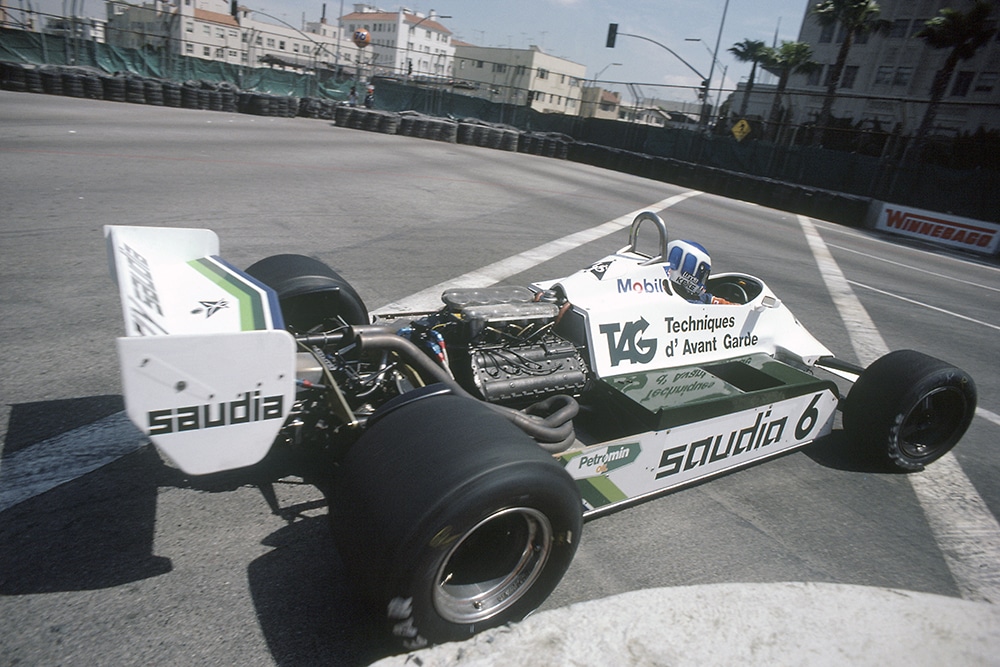
William’s Keke Rosberg set the 8th fastest time
© Motorsport Images
With the first three cars running well under the legal weight limit and carrying large plastic water containers, ostensibly to carry water for brake cooling, but in fact running with the container empty, there was a lot of “filling up to the normal level” before any weighing was done. Like last year’s ludicrous situation with the oleo-pneumatic raising and lowering of suspension systems to comply with the rules when the cars were checked, this year we are having a similar nonsense over cars running under weight. Renault have been forced to join in the cheating game and were running with a small water container, suggesting that their cars were down below the 580 kilogramme weight limit. Some of the Cosworth-powered cars were taking on as much as 12 gallons of water, which is 120 lb. (nearly 55 kilogrammes). However, the official results from the scrutineers’ weighing gave the following figures: Williams 606 kg., McLaren 590.5 kg., Renault 599 kg. and Ferrari 610.3 kg., so perhaps the designers have misguided ideas about the weights of their cars. It will be noticed that a Brabham was not weighed. Piquet came to rest at the lower end of the circuit half way through qualifying and the car was not returned to the pits. It was said that the engine had blown up, or was it a was of avoiding the official weighing?
On Saturday morning it all started up again under clear blue skies and it soon became evident that the McLaren team had got their MP4 working well on its Michelin tyres, and Lauda was applying all that skill and craft that he used to display with the Ferrari team. Driving smoothly, accurately and making a deliberate effort to keep away from the concrete walls, kerbs, and loose stuff off the racing line he was flowing round the circuit, making a lot of self-styled “aces” look rather amateurish. In contrast Andrea de Cesaris was putting all his youthful enthusiasm into the way he hurled the Alfa Romeo 182 round the circuit, and the two of them were coming up with similar results, the only difference being that you knew Lauda could keep it up for 75 laps if need be, while de Cesaris could only keep it up while his luck lasted. Even so, the way the new Alfa Romeo V12 was going was heartening to the Milanese team. As always, Alain Prost was quietly getting on with things, now with the right Michelins fitted, and he was up with the fast runners, so things were beginning to warm up nicely for the afternoon hour of qualifying, when the grid positions would be settled finally. While this test-session was at its height the Ferrari team called Pironi in and amid a certain amount of chuckling and smiles, they fitted his car with a remarkable rear aerofoil, mounted on a central pillar, that was actually two separate aerofoils, each complying with the dimension rules. This arrangement gave them a very wide aerofoil with a high aspect ratio, without infringing the letter of the rules, even if it infringed the spirit of the rules. The message was clear. If the Cosworth-powered teams were going to play silly b. . . . . . . s over the weight limit rules, then Ferrari was going to play the same game with aerodynamic rules. That the idea was serious was seen during the lunch break before qualifying when Villeneuve’s car was also fitted with this appendage, and if you read the rules as they were worded it was quite legal, even though it spread the aerodynamic effect over much more than the permitted 110 cm. width.
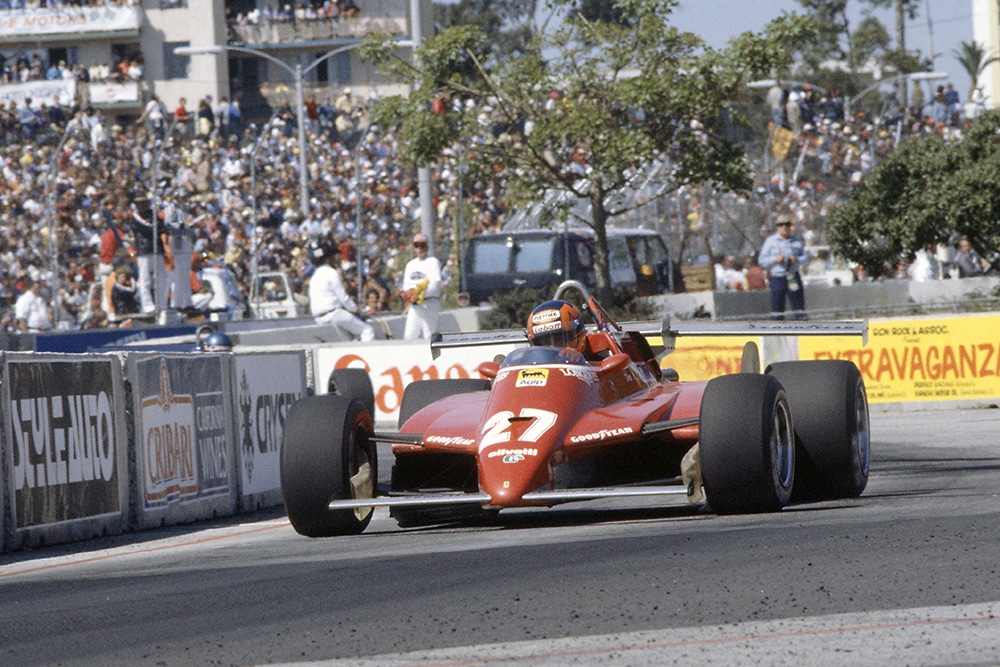
French Canadian Gilles Villeneuve qualified his Ferrari in 7th
Motorsport Images
At 1 p.m. the circuit was open again for serious qualifying, though to see the lethargic way some of the teams got off the mark you would not think it was serious. They could not be blamed for with each driver limited to two sets of tyres a “do-or-die” effort could be used up inside of ten minutes. It was nearly 20 minutes past 1 p.m. before the Ferraris joined in, and in the meantime Arnoux was at the top of the list with his Renault, while Rosberg, Lauda and Giacomelli were not far away. Piquet was one of the first out on the course, but was not making his usual progress, and it was becoming more and more obvious that Michelin tyres had a distinct advantage over Goodyear tyres on the rough-and-tumble street circuit. Laffite was late going out, not from choice, but because his engine had blown up in the morning and a new one had been fitted in an heroic effort by the Talbot-Ligier mechanics. Not unexpectedly de Cesaris bounced off a wall and returned to the pits with a flat tyre on the right rear, having smashed the wheel. Spins were still the order of the day, even among the top drivers, though contact with the walls was becoming less frequent.
The hairpin on to Shoreline Drive wins popular place for spins, especially when too much throttle was applied too soon, and the far end of bottom straight was also popular, caused by over-enthusiastic braking for the right-hand turn, or attempts to outdo another car under braking. Rosberg spun at this corner and in his excitement to get back on course he gave too much “stick” and ruined his clutch. He returned to the pits and took over the T-car, but all hopes of climbing higher up the grid were gone. Piquet was even more unfortunate, as he overdid it down the sharp drop on Linden Avenue and hit the wall at the bottom, ending his qualifying with the right front corner badly damaged. He had the small consolation of being the fastest car on Goodyear tyres, for by now the Michelin troops were massed solidly at the front. The methodical Lauda was making his presence felt in no small way, leaving his team-mate Watson far behind, which was ironical as the Ulsterman had been rash enough to say that Lauda was not number one in the team until he could prove his superiority! The two Renault drivers were up at the front as were the Alfa Romeo drivers, but the Ferraris were not really in the picture and Andretti was totally disappointing in the second Williams.

Reigning champion Nelson Piquet deals with an oversteering Brabham
© Motorsport Images
Whereas a time in the 1 min. 28 sec. bracket had been good, now that the heat was on you had to be in the 1 min. 27 sec. bracket to count, and Lauda was the first to set this new standard, though he was soon followed by Arnoux and Prost, while Giacomelli was very close as was de Cesaris. In the dying moments of the hour de Cesaris was all wound up tight, so much so that he was trembling visibly when he stopped, but it had resulted in a last lap of 1 min. 27.316 sec., to snatch pole position from Lauda’s 1 min. 27.436 sec. Heroic and emotional, but not very significant. Last year Patrese was the hero of the hour with pole-position in an Arrows, but it did neither him nor the team much good. This year the moment of glory was for de Cesaris and Alfa Romeo. The second place by Lauda was much more significant and the two Renaults right behind him were not only impressive, but ominous.
Down at the back of the field there was relief in the ATS team for their two drivers, Winkelhock and Salazar had just scraped on to the back of the grid, but despair in the Toleman team for Fabi was first non-qualifier, losing out by 0.16 sec. Paletti (Osella) Serra (Fittipaldi) and Baldi (Arrows) were the other three non-qualifiers. All credit to Bosel, Winkelhock, Borgudd, Guerrero, and Alboreto for qualifying comfortably on their first visit to Long Beach, and particularly to Michele Alboreto, the rather quiet woolly-haired Italian for qualifying his Tyrrell 011 in twelfth position, just above half-way.
For those people interested in things other than Formula One, it was all happening at Long Beach, for there were races for Formula Atlantic (won by Geoffrey Brabham), twin-engined Kart racing, Celebrity racing with Toyotas (in which “good old Dan Gurney” was second), a running race, a beauty contest (won by Brian Henton and Mauro Baldi with their A4 Arrows cars), a motorcycle race, a Speed Shop exhibition and some really skilful flying in the clear blue sky by a group of small aircraft indulging in “Sky Writing” with vapour trails. The whole affair was backed by Toyota and at 1.05 p.m. on Sunday there was a brief pause while the United States Grand Prix took place over 75 1/2 laps of the street circuit. It was due to run over 75 1/2 laps because the start is down by the shore where there is adequate space and the finish is up in the town, opposite the pits. It may seem a strange arrangement, but it works well.
Race
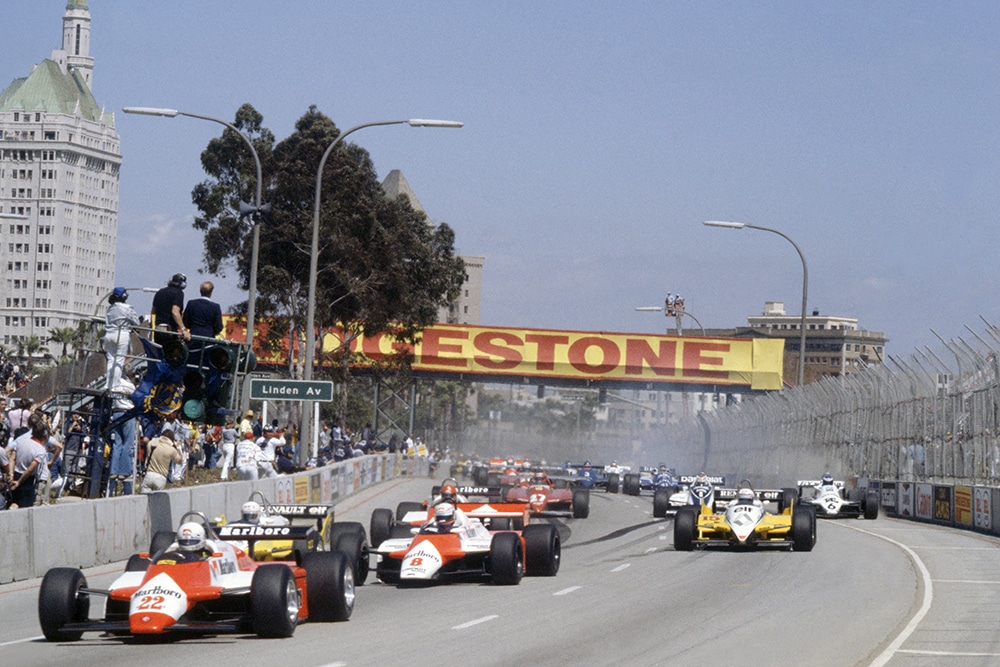
Andrea de Cesaris converts his pole into an early lead
Motorsport Images
In the half-hour warm-up on Sunday morning the twenty-six starters kept out of trouble and the McLaren team made it very clear that they had got a firm grip on the Long Beach situation. There were two types of Michelin tyre available to them and they put Lauda on the hard rubber and Watson on the soft rubber, thus hedging their bets each way. Lauda’s main problem was going to be the opening phase of the race, with the unpredictable Andrea de Cesaris ahead of him on the grid. If he could beat the Alfa Romeo driver to the first corner all would be well, but if he couldn’t. . .? Most people felt that de Cesaris would have an accident in the excitement and frenzy of being on pole-position for the first time in his traumatic Formula One career, and the idea seemed to be to not be too close to him when it happened, and preferably to be ahead of him.
Right on schedule the 26 cars left the pit lane and were driven round for a lap before lining up in grid order on the top straight. Then away they went in a rumbling crocodile round the twists and turns to line up once more on the bottom straight. Conditions were perfect, with a cloudless sky and a cool breeze, with a crowd of 82,000 paying customers spread around the circuit. The red light shone, then the green, and away they went, the young de Cesaris making a beautiful getaway to lead into the first corner. Unable to beat the Alfa on acceleration Lauda held station, but the cheeky Arnoux nipped by into second place, so Lauda was followed by Villeneuve, Giacomelli and Prost. It was all very orderly up at the front, but down at back Borgudd managed to collide with the two ATS cars. Next time round the only change was that Giacomelli had passed Villeneuve, but at the start of lap two Borgudd again collided with Winkelhock and this time the yellow and white ATS was left hors-de-combat. Watson overtook Alboreto on lap two and moved up into tenth place, but otherwise all was as before and it looked as though everyone had got the brakes on, not wishing to get too close to the leading Alfa Romeo. Give him his due, de Cesaris looked very confident out in front, but as no-one was putting pressure on him this may have been an illusion. The second ATS was out on lap four, when Salazar went wide in the new section of the course and hit the wall and the team claimed some sort of a record; the last two cars to qualify and the first two to retire! By this time de Cesaris had pulled out quite a commanding lead and it was pretty obvious that the rest of the race was being controlled by Arnoux running in second place.
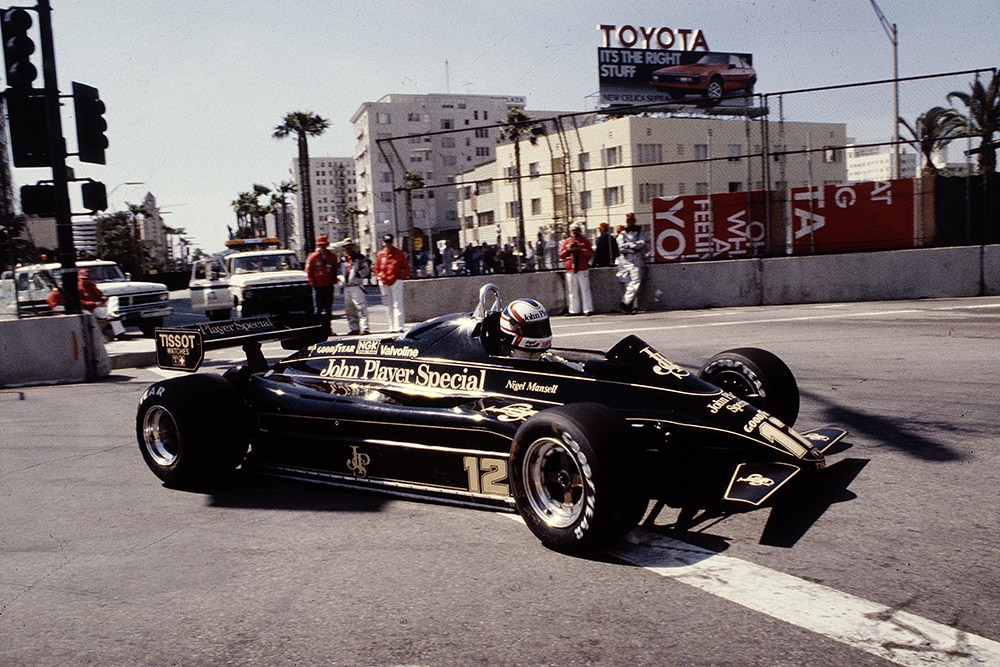
Nigel Mansell just missed out on a points-paying position
© Motorsport Images
On lap six the whole situation changed dramatically, for as Arnoux, Lauda and Giacomelli accelerated up to the hairpin to take them onto the fast downhill rush of Shoreline Drive, the little Italian was all set to have a go at the McLaren and snatch third place. As they braked for the hairpin Lauda fumbled a gear-change and rather than risk having the Alfa stuffed up his gearbox he moved over to the right, whereupon Giacomelli charged by on the left and promptly punted Arnoux’s Renault up the rear and both cars were eliminated on the spot. Lauda smiled quietly to himself as he took the hairpin, now in second place, while Giacomelli was mortified and Arnoux was furious. For once all had been going well with the Frenchman and his Renault felt perfect, so that he was mentally in the frame of mind for winning the race. His team-mate, the cool Mr. Prost was far from happy as his brakes were playing up and it was all he could do to hold on to a mediocre seventh place. The leaders were already spaced out, de Cesaris leading from Lauda and Villeneuve, but behind them Watson had been making good use of his softer tyres and had moved past Prost, Piquet and Rosberg and the accident promoted him to an instant fourth spot and closing on Villeneuve. Borgudd stopped at the pits to have some repairs done to his Tyrrell after his collisions and on lap nine Watson moved ahead of Villeneuve, but he was a long way behind his team-mate who seemed to be in no hurry to do anything about the leading Alfa Romeo. By this time, Pironi had quietly hit the wall on the entrance to the new section of the course and ended his race there and then, and a few laps later Prost ran out of brakes on his Renault and also hit a wall. At 12 laps we were already down to 19 cars and it looked like being the survival of the fittest.
At 13 laps Lauda obviously thought it was time he took the lead and he closed right up on the leading Alfa Romeo without any effort at all. On lap 15 de Cesaris came up to lap Boesel’s March at the chicane and as he hesitated Lauda shot by both of them and into the lead. It was all over. No-one could match the speed and precision of the Austrian ex-World Champion and de Cesaris had had his moment of glory. The famous and the not-so-famous were still bouncing off the walls, but Lauda was not putting a wheel wrong and coasted away into the middle distance. Andretti came into the pits with his left rear tyre flat and bent suspension as a result of contact with a wall, and though repairs were done one more lap convinced him that there was no point in continuing. At 20 laps the order was Lauda (McLaren), de Cesaris (Alfa Romeo), Watson (McLaren), Villeneuve (Ferrari), Rosberg (Williams), Piquet (Brabham), Alboreto (Tyrrell), Cheever (Talbot), Laffite (Talbot), Patrese (Brabham), de Angelis (Lotus), Jarier (Osella), Mass (March), Mansell (Lotus), Guerrero (Ensign), while Daly (Theodore), Boesel (March) and Henton (Arrows) had all been lapped and Borgudd (Tyrrell) was some laps behind. Rosberg and Villeneuve were having a bit of a scrap for fourth place and the Canadian tried a late-braking manoeuvre at the end of the bottom straight and overdid it. By the time he had gathered himself up the Finn had gone.
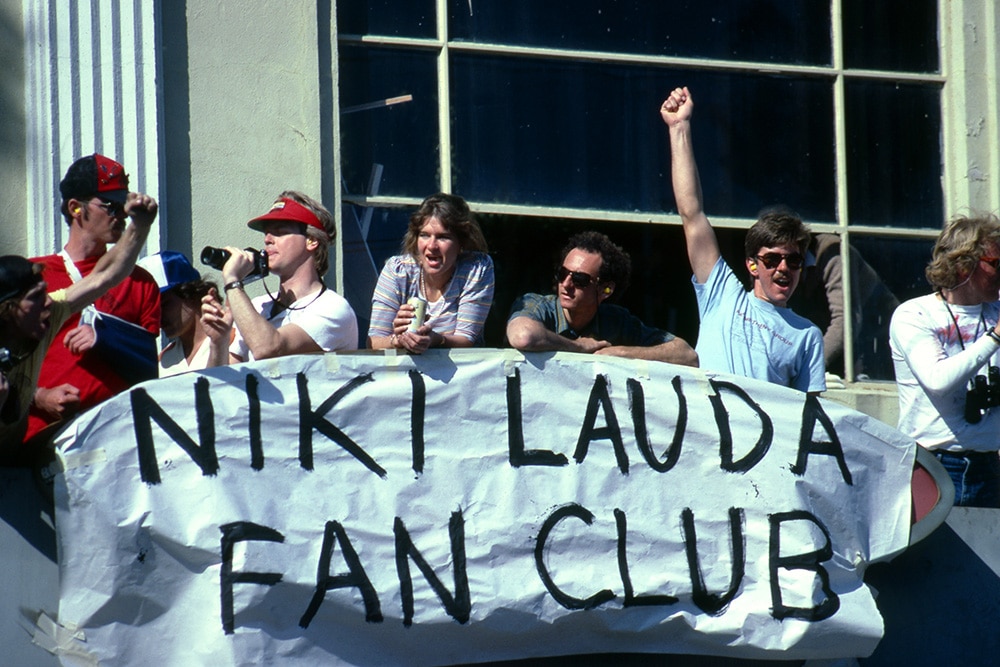
Members of the Niki Lauda Fan Club were rewarded with a victory for their hero
© Motorsport Images
Watson’s impressive burst of speed in the opening laps had rather used up his soft tyres and he was now paying the price with reduced adhesion and could do little to fend off Rosberg’s Williams, while Villeneuve and Alboreto were also closing in on him. After 29 laps he swept into the pits for another set of tyres, which dropped him down to eighth place, a lap behind his team-mate who was still circulating effortlessly in the lead. Like many before him Piquet hit a wall and put himself out of the race and many of the retired drivers were complaining about the tarmac surface breaking up on the new parts of the course. Off the racing line there was a layer of “marbles” and to put your wheels on to them was to ask for trouble. They were there for all to see and Lauda wasn’t having any trouble with them. Before Piquet went out Daly hit the wall and put the Theodore out and then Jarier retired without hitting anything, his Osella gearbox broken and Laffite spun on the loose stuff and stalled his engine. It would not restart so that was that. Guerrero lost control of the Ensign and slid into the wall and Henton nearly tangled with Borqudd and in avoiding the Tyrrell he got the Arrows onto the loose and that was that. There was no room for error and later Lauda was to say that there was about a three inch margin between staying on the track and sliding into the walls. He was clearly having no trouble staying within that limit and was not hurrying unduly.
On lap 34 de Cesaris’s valiant run in second place came to an end. He hit the wall in a big way and destroyed the right side of the Alfa Romeo but reckoned that the car had “sat down at the rear” just before he slid off into the wall. Something in the suspension could have broken, which would not have been surprising for he had been grazing the walls with his rear tyres a number of times. There was also a small fire as he stopped, as if a petrol pipe had come adrift, but it was soon extinguished. While he walked back to the pits the wreckage was dragged round to the pit lane by a breakdown truck.
There were now only twelve cars left running and all the drivers deserved a medal for keeping clear of trouble, but there was still a long way to go. In fact, the race had not yet reached the half-way point. When it was reached there was not much racing going on, the survivors being intent on surviving, though Alboreto was pressing Villeneuve and Patrese was about to overtake de Angelis, while Watson was making little progress on his new tyres. For a few laps things looked to be settling down, but then Cheever was into the pits for new tyres on his Talbot-Matra V12 and Alboreto had to give up his chase of the Ferrari when he could no longer find second gear in his Hewland gearbox. At 50 laps, complete stale-mate had set in, with Lauda circulating confidently in the lead 38 seconds ahead of Rosberg and he obviously had the situation well in hand, for his lead had been as much as 50 seconds and he was now really coasting along conserving his car, his fuel and his tyres in that calculating way of old, and equally not straining himself physically.
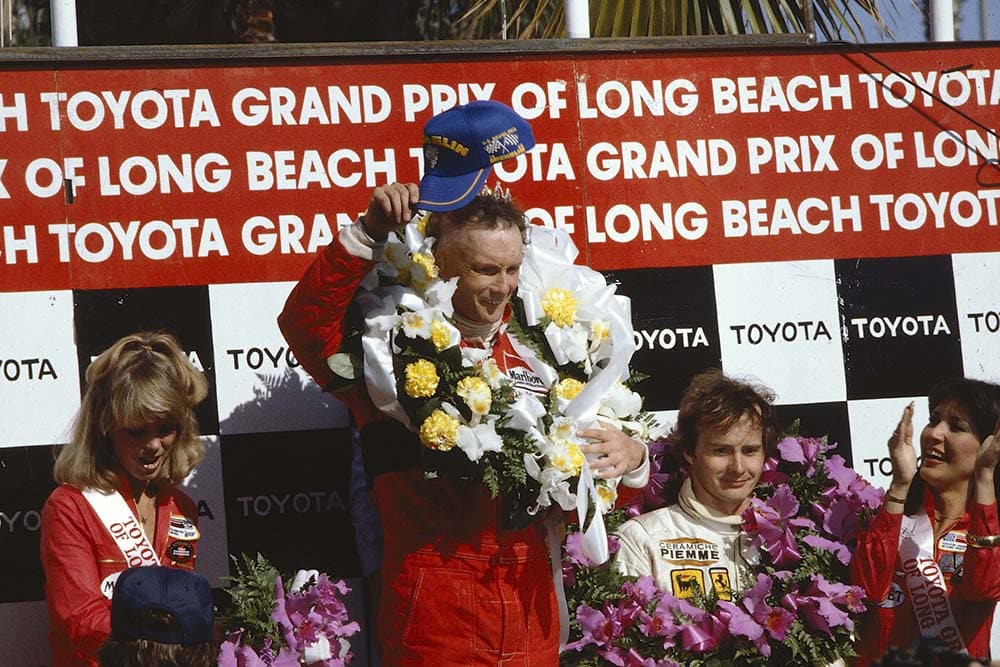
Winner Niki Lauda and 3rd place Gilles Villeneuve on the podium
© Motorsport Images
As the remaining laps ran out the only casualty was Cheever’s Talbot-Matra, which lost the oil from its gearbox and though Villeneuve, Mansell and Patrese were all reported as having made contact with walls no damage was done. Easing right back, to such an extent that Patrese and Alboreto unlapped themselves, Lauda cruised home to a splendid victory, a comfortable 14 seconds ahead of Rosberg in second place. In third place was the irrepressible Villeneuve in the turbo-charged Ferrari, followed by Patrese in the Brabham T-car and the worthy Alboreto in a Tyrrell 011. The rather disappointing Lotus 91 car finished sixth and eighth, with Watson’s McLaren between them and the two March cars of RAM-Racing brought up the rear. It was pretty obvious that the wide-open spaces of the “safety-circuits” get drivers into sloppy habits and when they are called upon to drive with precision the majority of them fail miserably. Clearly Lauda has lost none of his precision and track craft in his two-year “retirement” and Ron Dennis and John Barnard of the Marlboro Team McLaren were smiling like Cheshire cats after the race. Although Michelin tyres had appeared to dominate the scene at Long Beach there was only one car on the French tyres in the first six at the end of the race; however, that car finished first which is the important thing and the object of the exercise. As a race it had been rather dull, but as an object lesson it was valuable. Light relief was afforded after it was all over by Ken Tyrrell protesting the “twin-wing” on the rear of Villeneuve’s Ferrari. He did not protest that it was illegal, merely that it was a mis-interpretation of the rules! — D.S.J.
